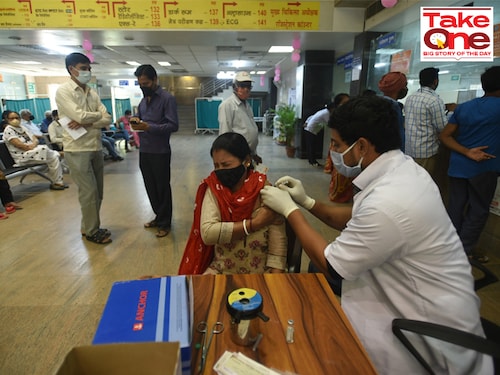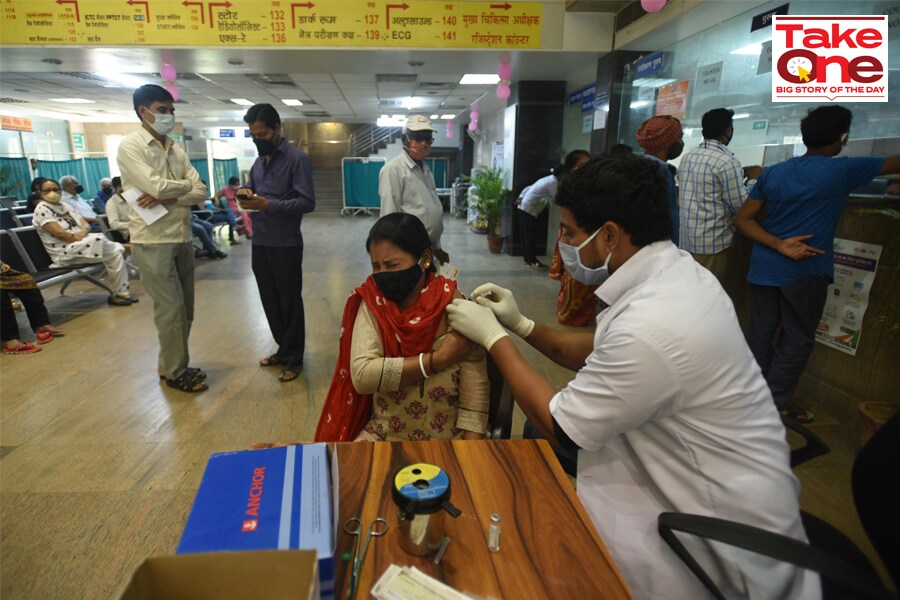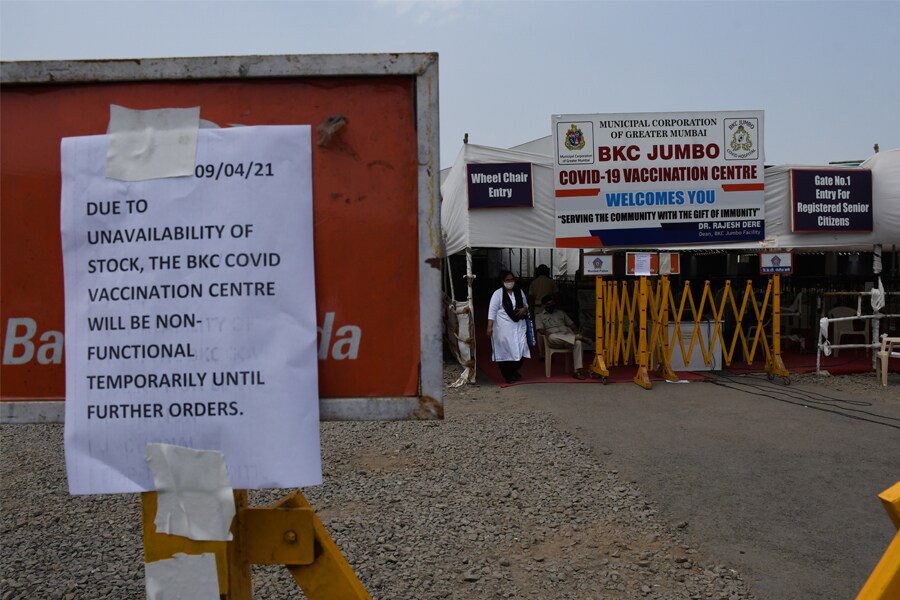Are there enough vaccines for everyone above 18?
The central government has devolved responsibility to the states and private sector to fast-track vaccinations. But experts point to inequities and lack of availability that might derail the process


 A woman above the age of 45 being vaccinated against Covid-19 a district hospital at sector 30, on April 16, 2021 in Noida, India.
A woman above the age of 45 being vaccinated against Covid-19 a district hospital at sector 30, on April 16, 2021 in Noida, India.
Image: Sunil Ghosh/Hindustan Times via Getty Images
India is all set to vaccinate nearly 60 percent of its population from May 1.
On April 19, as Covid-19 cases in the country swelled to record numbers, the Indian government announced a slew of changes to its coronavirus vaccination policy. India had begun vaccinations on January 16, and has so far vaccinated 125 million people. Of these, 16 million people have received both doses, while 109 million have received the first dose of either Covishield, commonly known as the AstraZeneca vaccine, or Covaxin, indigenously developed by Hyderabad-based Bharat Biotech.
“India’s National Covid-19 vaccination strategy has been built on a systematic and strategic end-to-end approach, proactively building capacity across R&D, manufacturing and administration since April 2020," the government said in a statement. “While pushing for scale and speed, it has simultaneously been anchored in the stability necessary to sustainably execute the world’s largest vaccination drive."
Under the revised plans, the Narendra Modi government has essentially shifted control of the vaccination programme from its own clutches to state governments and the private sector, which it reckons will help in ramping up vaccine coverage in the country.
“This would augment vaccine production as well as availability, incentivising vaccine manufacturers to rapidly ramp up their production as well as attract new vaccine manufacturers, domestic and international," the government’s statement said.
“It would also make pricing, procurement, eligibility and administration of vaccines open and flexible, allowing all stakeholders the flexibility to customise to local needs and dynamics."
The revised scheme requires vaccine manufacturers to supply 50 percent of their doses to the central government, while the remaining can be supplied to state governments and to the open market. The government will continue to provide vaccines free of cost, while state governments and the private sector will be allowed to sell at a price that they have agreed upon with the manufacturer. However, domestic manufacturers will have to declare the price it will charge state governments before May 1.
Meanwhile, vaccines that are being imported and are ready to use don’t need to be sold to the central government, and can directly be sold to state governments or the private sector, including hospitals and industrial establishments looking to vaccinate their employees. The government hasn’t confirmed the pricing policy for these vaccines.
States, however, are still awaiting more information from the government on how these changes will be implemented. J Radhakrishnan, health secretary of Tamil Nadu, told Forbes India that it is “too early to comment because we do not know what kind of provisions, they [the Centre] are looking at".
According to him, it might be “a tough call" for states to procure vaccines at market prices, but without the exact details of the procurement process it will be difficult to comment on the implications of this development.
The central government will, meanwhile, allocate vaccines to states based on numerous parameters, including the extent of infection, speed of administration and vaccine wastage. India is currently the second-worst Covid-19 affected country, with over 15 million cases. However, despite a surge in numbers, it has also seen as much as 23 percent of its vaccines being wasted, with five states—Tamil Nadu, Haryana, Punjab, Manipur and Telangana— accounting for the highest wastage.
“Rather than planning to fulfil its original target of priority vaccination of all health-care personnel, first responder workers, people aged 65 and above, and those above 45 with co-morbidities, it has now abandoned that plan, and thrown vaccination open to all adults without any plan regarding actual delivery," says Satyajit Rath, a scientist at the National Institute of Immunology and the adjunct professor at the Indian Institute of Science Education and Research.
Where will the vaccine come from?
So far, India had been vaccinating its large populace with just two vaccines, Covishield and Covaxin. In early April, it became the fastest country in the world to give more than 100 million doses, a feat that it achieved in 85 days, compared to 89 days in the US and 102 days in China. Yet, over the past few weeks, the country has been grappling with a severe vaccine shortage.
Making vaccines available in the open market would definitely fast-track the vaccination drive, says Dr Azad Moopen, founder chairman and managing director of Aster DM Healthcare. He points out that the sero-positivity levels in different states vary from as low as 15 percent to a high of 40 percent. “I consider the second wave as a nationwide emergency that has to be dealt with on war-footing… we have to get to herd immunity levels of 75 to 80 percent through vaccination for controlling the pandemic. The government must procure sufficient quantities of vaccines and make arrangements for its administration immediately," he says. “There is no shortcut—otherwise, there will be a collapse of the health care system, the loss of many lives, and a huge impact on the economy."
Covishield, manufactured by Pune-based Serum Institute of India (SII), has accounted for 90 percent of vaccinations in the country. A two-dose viral vector vaccine, it has an efficacy of 79 percent. On April 19, SII CEO Adar Poonawalla thanked the Prime Minister for opening up the vaccination programme and for providing “financial aid" that will help vaccine production and distribution.
Poonawalla, whose company SII makes between 60 and 70 million vaccine doses a month, is looking to ramp up production to 100 million doses. For this, he had sought Rs 3,000 crore from the government the government approved the request on April 20, and provided the amount in advance to SII. The move is also likely to help the company meet its global commitments as part of its deal with British pharma company AstraZeneca, and the global vaccine sharing platform, Covax.
 Over the past few weeks, the country has been grappling with a severe vaccine shortage. Seen here, a board put up outside Mumbai"s Bandra Kurla Complex (BKC) jumbo vaccination centre stating that vaccination centre is temporarily shut down
Over the past few weeks, the country has been grappling with a severe vaccine shortage. Seen here, a board put up outside Mumbai"s Bandra Kurla Complex (BKC) jumbo vaccination centre stating that vaccination centre is temporarily shut down
Image: Deepak Turbhekar
However, despite the government’s aid to ramp up capacity, SII has been grappling with constraints on the raw material front. On April 13, he had tweeted to US President Joe Biden, requesting his help in lifting embargoes on the export of raw material from the US. While Poonawalla did not mention the specific raw materials needed, vaccines usually require filters, bags, and adjuvants (substances that increase a vaccine’s efficacy), in addition to large, sterile plastic bags.
Bharat Biotech, manufacturers of Covaxin, also received Rs 1,500 crore in advance from the Indian government and is laying out plans to ramp up production to 700 million doses annually. Currently, it produces roughly 5 million doses a month. The ramp-up will also help it sell the vaccine to global markets, from where it has received orders.
“Inactivated vaccines, while highly safe, are extremely complex and expensive to manufacture, resulting in lower yields when compared to live virus vaccines," said a statement from Bharat Biotech on April 20.
“Capacity expansion in vaccine manufacturing is a long and tedious process, requiring investments of several millions of rupees and several years. Manufacturing partnerships are being explored with our partners in other countries, who have prior expertise with commercial scale manufacture of inactivated viral vaccines under biosafety containment."
The company also has a partnership with Hyderabad-based Indian Immunologicals (IIL) to manufacture the drug substance for the inactivated viral vaccine. “The technology transfer process is well underway and IIL has the capabilities and expertise to manufacture inactivated viral vaccines at commercial scale and under biosafety containment," Bharat Biotech said.
The ramp-up in capacity, however, isn’t likely to ease the ongoing Covid-19 crisis in India. This is because vaccines usually take two weeks from the second dose to build immunity. Which means ramping up vaccination will not have an immediate effect on the number of cases.
“The government of India could have been far more proactive than it was in encouraging and facilitating collaborations between Indian vaccine manufacturers and global vaccine developers," adds Rath. “It could have used this past year to rebuild capacity in its own [deliberately] moribund public-sector vaccine manufacturing enterprises. It could have funded its own researchers in their vaccine development efforts with actual funds rather than with empty words."
Over the past month alone, India added more than 3 million Covid-19 cases, prompting the government to hasten its vaccine approval process: It approved Sputnik V, manufactured by Dr Reddy’s, and removed its stringent vaccine approval policy.
Dr Reddy’s has a contract with the Russian Direct Investment Fund (RDIF), the sovereign wealth fund of the Russian government, to supply 125 million people doses (250 million vaccines units) as part of a deal it signed last September. The company is looking to import bulk vaccine doses between mid-April and June, and has made arrangements for their safe transportation at the required temperature of -18°C. The vaccine price hasn’t been announced yet, but it could be less than Rs 750, keeping in line with global trends.
“The government could have aggressively encouraged and facilitated "bridging trials" of even remotely promising vaccine candidates from across the world," adds Rath. “It could have invested in structurally strengthening its far-flung de-centralised public health care system with new [regular] employment at all levels, with up-skilling and with resources, so as to prepare it for a vaccination campaign of unprecedented scale and duration. It could have invited and approved vaccines such as the mRNA-based vaccines, whose cold-chain requirements mean they cannot be used anyway in a nation-wide vaccination campaign, for the private, upper-class metropolitan market where they would have been used to some extent without any competition or hoarding leading to scarcity in the national campaign."
Until the first week of April, even globally approved vaccines had to undergo rigorous trials in India before the government approved them. The move made sense until early January, when India began its vaccination drive and was well past the peak of its first Covid-19 wave. On April 13, the government-appointed National Expert Group on Vaccine Administration for Covid-19 (NEGVAC) gave its nod to allow vaccine-makers such as Pfizer or Moderna to bring their vaccines to India without having to conduct the mandatory phase 2 and 3 clinical trials.
Instead, they will need to do a ‘bridging trial’, which mean the first 100 volunteers will be assessed and observed for seven days to monitor for more severe and immediate side effects. After that, the vaccines will be rolled out for the entire country.
Pharma companies such as Johnson & Johnson (J&J) and Pfizer are gearing up to sell their vaccines in India. “Johnson & Johnson is partnering with health authorities and the world’s best scientists to provide the safety and efficacy data necessary to support worldwide emergency use of the Janssen Covid-19 vaccine candidate," said a J&J spokesperson.
“In line with this commitment, we have submitted an application to the Drugs Controller General of India [DCGI] requesting approval to conduct a bridging clinical study of our single-dose Janssen Covid-19 vaccine candidate in India to comply with local regulations."
J&J has entered a deal with Hyderabad based Biological-E to manufacture more than 500 million doses of its single-dose vaccine. Pfizer, whose mRNA vaccine has over 90 percent efficacy, is also working with the government to make the vaccine available in India.
"Pfizer remains committed to continuing our engagement with the government towards making the Pfizer and BioNTech vaccine available for use in the government’s immunization program in the country," a spokesperson for Pfizer told Forbes India. "As we have stated earlier, during this pandemic phase, Pfizer will prioritize supporting governments in their immunization programs and supply the Covid-19 vaccine only through government contracts based on agreements with respective government authorities and following regulatory authorization or approval."
Meanwhile, the country’s long-term supply will get a boost from the indigenously developed ZyCov-D vaccine, manufactured by Ahmedabad-based Zydus Cadila, which is expected to file for emergency approval in June, based on clinical trials that are likely to be completed by May.
Can things change?
Moopen, of Aster DM Healthcare, believes that supply chain and administrative issues have to be addressed, with vaccination centres being started across the country and retired health care professionals, apart from post-graduate medical students, being pulled into this campaign. “Fifty percent of the population, including the BPL [below poverty line] people, must be provided vaccines free of cost through the government facilities. The rest of the population who can afford it must be urged to avail vaccination through the private sector. The government should cap the prices for vaccination by the private sector to avoid profiteering," he says.
Public health experts add that open market procurement of vaccines might aggravate inequities in access. “At the heart of inequalities in public health is markets. So we do not need a ‘liberalised’ vaccine strategy. You would, in fact, need to govern it further where you push various stakeholders, be it private companies, hospitals and doctors to ensure equal distribution of vaccines," says Prashanth N Srinivas, assistant director (research), Institute of Public Health, Bengaluru. He points to how platforms like Covax by the World Health Organization (WHO) exist specifically to create a counter-pressure on market mechanisms so that vaccines and resources can be pooled in to help the most vulnerable. “I hope the government will very quickly follow up with stricter norms on how to prevent distortion of vaccine access by private market mechanisms."
The government, however, maintains that there will be no inequities in vaccine access. “The vaccines will still be administered under the supervision of hospitals, so it is not as if people will be able to buy the vaccines in the open market," says RS Sharma, CEO of the National Health Authority, who has been playing an important role in India’s response to Covid-19 as the chairman of the Empowered Group on Vaccine Administration. “Why should the poor not have access to vaccines?
Fifty percent of the total vaccine capacity is still with the government. Our existing tech platforms and tracking mechanisms are also scalable enough to take care of all the additional vaccination needs of this country."
Experts, however, feel that things may not proceed smoothly. Rath says that while India has been boasting of vaccinating close to 12 crore people in three months, the reality is that not even 2 crore have been fully vaccinated with two doses even the 12-crore people who have received the first dose represent only about 8 percent of the population. “Added to this is the fact that daily vaccinations reached a peak in early April, with over 40 lakh doses given on April 2, but by mid-April, this pace has come down to about half of that peak level," he says. “Obviously, it is likely to take many months before the fully vaccinated make up the majority of the population yet, that is what is probably needed for vaccination per se to have a major effect on future Covid-19 outbreaks."
Srinivas, of the Institute of Public Health, says that it is most important to ensure that there is no capture of vaccine supplies by those who can pay for them, be it states, private players or other entities. “Vaccines should be made available based on who can pay, but based on universal principles. Because no one is protected against Covid-19 until we’re all protected and vaccinated."
So what does the latest policy revision mean for India’s vaccination programme? “The government has both abrogated its responsibility for acquisition and delivery of vaccines by making the states directly responsible for half the vaccine doses," says Rath. “It has deregulated this half of the vaccine market by removing price controls. None of this looks or sounds like a "plan".Instead, this appears a cynical exercise in outsourcing vaccination responsibility and blaming hapless state governments, and in providing vaccine "super-profits", to use Adar Poonawalla"s phrase, to the private sector."
First Published: Apr 20, 2021, 17:57
Subscribe Now